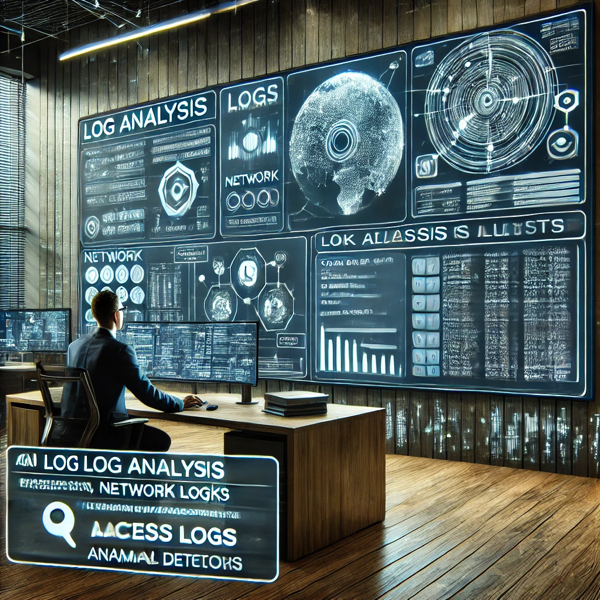Introduction
Managing log data efficiently has become both a necessity and a challenge.
Log data, ranging from network traffic and access records to application errors, is essential to cybersecurity operations,
yet the sheer volume and complexity can easily overwhelm even the most seasoned analysts. AI-driven log analysis promises
to lighten this burden by automating initial data reviews and detecting anomalies. But beyond automation, an ideal AI
solution should foster a partnership with analysts, supporting and enhancing their intuitive insights.
Building a “Chat with Logs” Interface: Driving Curiosity and Insight
At the heart of a successful AI-driven log analysis system is a conversational interface—one that enables analysts to “chat” with logs. Imagine a system where, rather than parsing raw data streams line-by-line, analysts can investigate logs in a natural, back-and-forth manner. A key part of this chat experience should be its ability to prompt curiosity.
The AI could leverage insights from past successful interactions to generate prompts that align with common threat indicators.
For instance, if previous analysts identified a spike in failed access attempts as a red flag for brute force attacks, the AI
might proactively ask, “Would you like to investigate this cluster of failed access attempts around 2 AM?” Prompts like these,
rooted in past experiences and threat models, can draw analysts into deeper investigation and support intuitive, curiosity-driven workflows.
Prioritizing Log Types and Formats
The diversity of log formats presents both an opportunity and a challenge for AI. Logs from network traffic, access logs,
application errors, or systems events come in various formats—often JSON, XML, or text—which the AI must interpret and standardize.
An effective AI-driven system should accommodate all these formats, ensuring no data source is overlooked.
For each type, AI can be trained to recognize particular indicators of interest. Access logs, for example, might reveal unusual
login patterns, while network traffic logs could indicate unusual volumes or connection sources. This broad compatibility ensures
that analysts receive a comprehensive view of potential threats across the organization.
A Cooperative Model for AI and Analyst Collaboration
While AI excels at rapidly processing vast amounts of log data, it cannot entirely replace the human element in security analysis.
Security professionals bring domain expertise, pattern recognition, and, perhaps most importantly, intuition. A cooperative model, where AI and analysts work side-by-side, allows for a powerful synergy: the AI can scan for anomalies and flag potential issues, while the analyst applies their knowledge to contextualize findings.
The interface should support this interaction through a feedback loop. Analysts can provide real-time feedback to the AI, indicating false positives or requesting deeper analysis on particular flags. A chat-based interface, in this case, enhances fluidity in interaction. Analysts could ask questions like, “What other systems did this IP address connect to recently?” or “Show me login patterns for this account over the past month.” This cooperative, conversational approach can make the AI feel less like a tool and more like a partner.
Privacy Considerations for Sensitive Logs
Log data often contains sensitive information, making data privacy a top priority. While on-device, local AI models offer strong protection,
many organizations may find private instances of cloud-based models secure enough for all but the most sensitive data, like classified logs or those under nation-state scrutiny.
In these cases, private cloud instances provide robust scalability and processing power without exposing data to external servers. By incorporating
strict data access controls, encryption, and compliance with regulatory standards, such instances can strike a balance between performance and security.
For highly sensitive logs, on-premises or isolated deployments ensure data remains under complete control. Additionally, conducting regular AI model
audits can help verify data privacy standards and ensure no sensitive information leaks during model training or updates.
Conclusion: Moving Toward Cooperative Intelligence
AI-driven log analysis is transforming the landscape of security operations, offering a path to enhanced efficiency and effectiveness. By providing
analysts with a conversational interface, fostering curiosity, and allowing for human-AI cooperation, organizations can create a truly intelligent log
analysis ecosystem. This approach doesn’t replace analysts but empowers them, blending AI’s speed and scale with human intuition and expertise.
For organizations aiming to achieve this synergy, the focus should be on integrating AI as a collaborative partner. Through feedback-driven interfaces,
adaptable privacy measures, and a structured approach to anomaly detection, the next generation of log analysis can combine the best of both human and
machine intelligence, setting a new standard in security operations.
More Information:
While this is a thought exercise, now is the time to start thinking about applying some of these techniques. For more information or to have a discussion about strategies and tactics, please contact MicroSolved at info@microsolved.com. Thanks, and we look forward to speaking with you!
* AI tools were used as a research assistant for this content.

